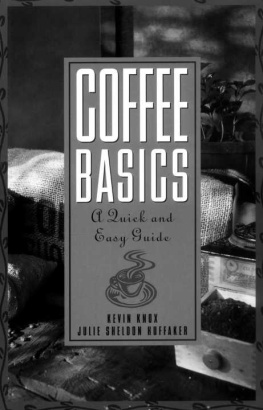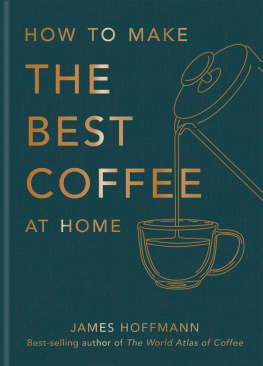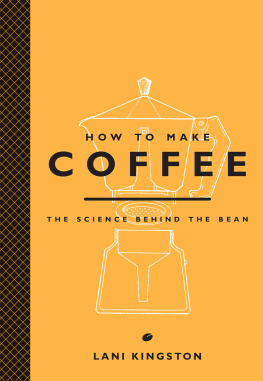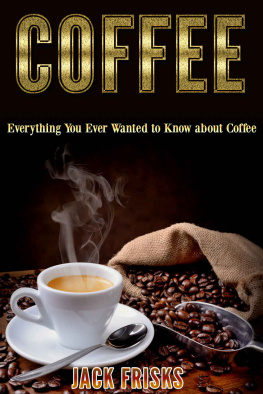





CONTENT S
ix
xiii
CHAPTER 1
CHAPTER 5 41
P R E F A C E
Many volumes on coffee have been written, including a few that merit designation as classics. With all of these publications available and more glossy coffee-table tomes than one can set a cup upon, is there truly need for yet one more book on the subject?
Our affirmative answer to this question is a book thatto a greater degree than its predecessors- attempts to break down the barriers that exist between the world of the coffee professional and that of the consumer. Our goal is to walk readers down an unswerving path to superlative coffee. We want you to know the unvarnished truth: What's out there that's great? What's called great, but isn't? Why do some of the most popular brewing methods give you the least value for your dollar?
Between the two of us, we have roasted and brewed a great deal of coffee over the past twenty years. We've had the privilege of talking with customers at every level of sophistication. And, as we interact with an ever widening world of coffee drinkers, we're struck by the perceptual gulf between the customers who buy good coffee and the professionals whose lives revolve around it. Taste is ultimately a subjective matter. The road that leads there, however, is as objective as asphalt and full of pitfalls. There are basic truths governing the ability of a region to grow good coffee and of a roaster to sculpt its taste. There are coffees that have been processed well and those that have not, and there are straightforward formulas that yield exponentially better coffee than most consumers currently brew at home. We want to talk about these in accessible detail, and share with you some secrets for getting the most pleasure out of every coffee dollar you spend.
Since one of this book's authors buys and roasts coffee for a living, one might well question the inherent subjectivity of the text. Before you turn to page 1, we wish to make this abundantly clear: Despite the objectivity of much of the information presented, our overall approach to fine coffee is obstinately, passionately subjective. How could it possibly be any other way and still possess meaning?
The world of fine coffee is closely aligned with that of the exacting wine maker or accomplished chef. Fine coffee is unequivocally subjective in nature, a question of taste. Artisan roasters and brewers are tastemakers, distinguished by the informed personal stamp they lend to their products. As an enlightened consumer, your task is to seek out sources and brewing methods for your coffees whose respective preferences and emphasis most closely match your own.
Additionally, we want to demystify some of the more behind-the-scenes issues that make their way into the cup: Where issues such as decaffeination processes, organic coffees, coffee worker's rights, and world market pricing are concerned, what is the buzz all about?
There are basics, and there are beyond-basics; in all honesty, we've not stopped ourselves from providing a healthy amount of both. We believe that the more you know about coffee, the more you will enjoy each encounter with it. In an attempt to save you from being completely overwhelmed, however, we have tried to curb ourselves from presenting overly exhaustive detail.
American coffee pioneer George Howell moves through life with the motto, "In search of the ultimate cup," proffering an invitation to participate in a quest that has a beginning but, truly, no end. We hope that Coffee Basics will contribute significantly to expanding your horizons.
ACKNOWLEDGMENT S
While this is a relatively short book, the acknowledgment of all who have contributed to making it possible could easily reach chapter length.
My foremost debt is to my friend and co-author Julie Sheldon Huffaker. Her perceptiveness, sensitivity, writing skills, and love for the cultures from which coffee springs turned what could have been an esoteric project, of interest only to trade insiders, into a book that stands firmly on the consumer's side of the counter.
My wife, Erin, has borne the weight of being a "book widow" with grace and endless support.
Professional debts run wide and deep: I can hardly imagine another industry so full of passionate, talented people. Jeffrey Cohn, founder and chairman of Allegro Coffee Company, gave me my first opportunities in coffee and has been a friend and mentor for nearly 20 years. Terry Tierney, president of Allegro, has also been a key mentor and supporter, and he, along with our roasting and quality control staff, made it possible for me to take time to write.
Jerry Baldwin and Jim Reynolds, both of Peet's Coffee and Tea, taught and continue to teach others who love coffee what quality without compromise is all about; without their example, I would never have found a career in coffee. Expert roasters Steve Smith, Michael Dice, and Tom Walters showed me how to turn dedication to excellence into a cooling tray of delicious proof.
On another coast, and at another roast, lives George Howell, founder of Boston's Coffee Connection and one of the coffee world's most knowledgeable and passionate spokesmen. I know of no one who has done more to improve the quality of American coffee, and no one has taught me more, both directly and by example.
Howard Schultz and Dave Olsen, both of Starbucks, gave me the opportunity to cram several decades worth of growth and learning into a few short years in Seattle. Seattle is also the home of pioneering espresso machine importer and manufacturer Kent Bakke of Espresso Specialists, from whom I continue to learn much about coffee and life, and their particular Italian inextricability.
Green coffee growers, importers, and exporters also contributed mightily to the educational process from which this book springs. I owe special thanks to my multitalented green-coffee broker/writer/connoisseur friend Tim Castle, of Castle and Company.
The list of farmers who have contributed great coffees and learning opportunities could itself fill a small book, but I am especially indebted to Bill McAlpin of Hacienda La Minita for his generous education regarding the complex and subtle relationships between farming practices and final cup quality.
I'm also indebted to the following green-coffee importers for great learning opportunities and great coffees: Alan Odom and Alan Nietlisbach of Holland Coffee; Erna Knutsen at Knutsen Coffees, Michael Glenister of Amcafe; Robert Fullmer at Royal Coffee; Mohamed Moledina of Moledina Commodities; Jeremy Woods of American Coffee; and Wolfgang Dehner of List & Beisler.
-Kevin Knox
At the risk of plagiarizing my co-author's work, I feel compelled to return the initial sentiments of his acknowledgments in kind. Years ago, when I first began working as a barista for Starbucks Coffee Company, Kevin took the time to meet with me on the strength of an impassioned letter. Over one of his exquisite and legendary dinners, he invited me to discuss coffee at length-and this book is evidence of the delightful fact that our conversation never ended.














